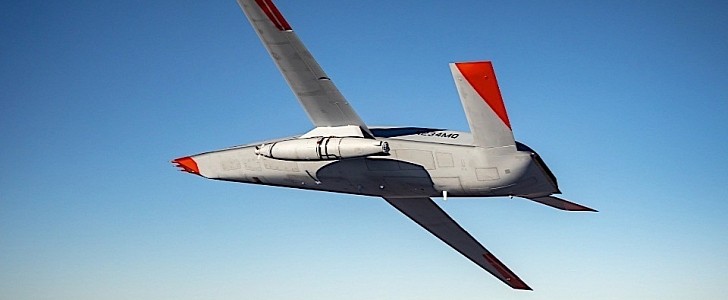We live in an age when military drones are a hard reality. The armies of the world have been using the tech for years, in separate ops than the ones conducted with piloted aircraft, and with a great degree of success. But the future will be the one where crewed aircraft and unmanned drones work together.
The concept is called manned-unmanned teaming (MUM-T), and it’s something both the American military and the companies tasked with supplying drone systems have been working on for a while. And the latest breakthrough was announced this week by Boeing.
Among other things, the company is making something called MQ-25 Stingray. Powered by a Rolls-Royce engine that gives it a range of about 580 miles (930 km), it’s meant to give the U.S. Navy increased capabilities by acting as a flying fuel station.
That’s right, the drone’s primary role is refueling, as it can carry 15,000 lbs (6,800 kg) of fuel inside something called aerial refueling store (ARS). But this is a drone we’re talking about, hence it could be used for far more than that. Like, say, intelligence, surveillance and reconnaissance (ISR) missions.
During a recent digital test, Boeing says it proved the drone can successfully conduct ISR, even during MUM-T ops, thanks to a “new open autonomy architecture.”
The tests ran by Boeing called for an E-2D Advanced Hawkeye, a P-8A Poseidon and an F/A-18 Super Hornet to directly task the drone with conducting ISR, “without traditional communications with the ship-based ground control station.”
During the virtual run, the Stingray was only shown the target area that needed to be surveyed, and the drone did the rest on its own – it validated the command, planned the route, and ran the search pattern.
“Large swaths of ocean could be surveilled, identified and targeted when MQ-25 is teamed with carrier-based assets such as the E-2D or the land-based P-8A patrol aircraft,” said in a statement Don “BD” Gaddis, director, MQ-25 Advanced Design.
“Through this demonstration, our customers saw how this digital, open approach to MUM-T is key to fielding critical warfighting capability at much lower cost and with greater speed and agility.”
One year ago, Boeing said it’ll build a new, 300,000 square-foot (27,870 square meters) facility at MidAmerica St. Louis airport in Illinois, where it plans to build Stingrays. The facility should be up and running by 2024, so it’s only later in the decade that we’ll have to get used to seeing MQ-25s in the sky.
Among other things, the company is making something called MQ-25 Stingray. Powered by a Rolls-Royce engine that gives it a range of about 580 miles (930 km), it’s meant to give the U.S. Navy increased capabilities by acting as a flying fuel station.
That’s right, the drone’s primary role is refueling, as it can carry 15,000 lbs (6,800 kg) of fuel inside something called aerial refueling store (ARS). But this is a drone we’re talking about, hence it could be used for far more than that. Like, say, intelligence, surveillance and reconnaissance (ISR) missions.
During a recent digital test, Boeing says it proved the drone can successfully conduct ISR, even during MUM-T ops, thanks to a “new open autonomy architecture.”
The tests ran by Boeing called for an E-2D Advanced Hawkeye, a P-8A Poseidon and an F/A-18 Super Hornet to directly task the drone with conducting ISR, “without traditional communications with the ship-based ground control station.”
During the virtual run, the Stingray was only shown the target area that needed to be surveyed, and the drone did the rest on its own – it validated the command, planned the route, and ran the search pattern.
“Large swaths of ocean could be surveilled, identified and targeted when MQ-25 is teamed with carrier-based assets such as the E-2D or the land-based P-8A patrol aircraft,” said in a statement Don “BD” Gaddis, director, MQ-25 Advanced Design.
“Through this demonstration, our customers saw how this digital, open approach to MUM-T is key to fielding critical warfighting capability at much lower cost and with greater speed and agility.”
One year ago, Boeing said it’ll build a new, 300,000 square-foot (27,870 square meters) facility at MidAmerica St. Louis airport in Illinois, where it plans to build Stingrays. The facility should be up and running by 2024, so it’s only later in the decade that we’ll have to get used to seeing MQ-25s in the sky.




















